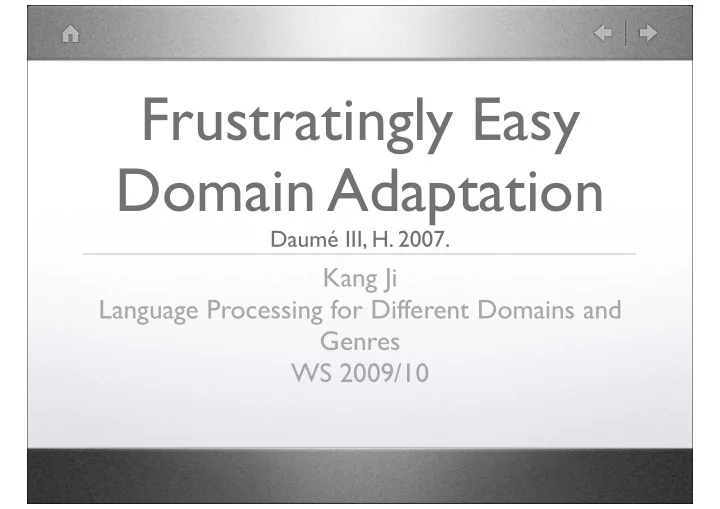

Frustratingly Easy Domain Adaptation Daumé III, H. 2007. Kang Ji Language Processing for Different Domains and Genres WS 2009/10
Overview • Motivation • Annotation • Core Approach • Prior Works • Feature Annotation • Kernelized Version • Some Experimental Results
A common special case • Suppose we have a NLP system focusing on news document, and now want to migrate it into biographic domain Would there be any difference if we • have quite some biographic documents(target data) and lots of news documents. • only have news documents(source data).
Rough Idea Source Data Combined New Input Feature Space ML System Target Data
ML approaches • Now we simplified the task to a standard machine learning problem • Fully supervised learning: annotated corpus • Semi-supervised learning: large unannotated corpus, annotated corpus from the later target data
Some Annotations • Input space Ҳ • Output space Ҷ • Samples: D ˢ D ᵗ D ˢ is a collection of N examples and D ᵗ is a collection of M examples (where, typically, N ≫ M).
Some Annotations • Distribution on the source and target domains: D ˢ D ᵗ • learning function h : Ҳ → Ҷ Ҳ = R F and that Ҷ = { − 1,+1}
Prior works • The SRCONLY baseline ignores the target data and trains a single model, only on the source data. • The TGTONLY baseline trains a single model only on the target data. • The ALL baseline simply trains a standard learning algorithm on the union of the two datasets.
Prior works • The WEIGHTED baseline: re-weight examples from D ˢ . in case that N ≫ M , so if N = a × M, we may weight each example from the source domain by 1/a.
Prior works • The PRED baseline is based on the idea of using the output of the source classifier as a feature in the target classifier. • The LININT baseline, we linearly interpolate the predictions of the SRCONLY and the TGTONLY models.
Prior works • The PRIOR model is to use the SRCONLY model as a prior on the weights for a second model, trained on the target data. • The maximum entropy classifiers model by Daum´e III and Marcu (2006), learns three models and justifies on a per-example basis.
Feature Augmentation · Φ ˢ , Φ ᵗ : Ҳ → Ẋ mapping for source and target data respectively, then define Ẋ = R 3F , we get · Φ ˢ (x) = <x,x,0>; Φ ᵗ (x)=<x,0,x> · the features which are made into three: general version, source-specific version, target-specific version · get some ideas? examples coming---> black board
a simple and pleasing result • Ǩ (x, x ′ ) = 2K(x, x ′ ) same domain • Ǩ (x, x ′ ) = K(x, x ′ ) diff. domain • the data point from the target domain has twice as much influence as the data point from source domain on the prediction of the test target data.
Extension to Multi-domain adaption • For a K-domain problem, we simply expand the feature space from R 3F to R (K+1)F • “+1” stands for the “general domain”
Why better • This model optimize the feature weights jointly, thus there’s no need to cross- validate to estimate good hyperparameters for each task as the PRIOR model does. • Also it means that the single supervised learning algorithm that is run is allowed to regulate the trade-off between source/ target and general weights.
Task Statistics • Table 1: Task statistics; • columns are task, domain,size of the training, development and test sets, and the number of unique features in the training set. • Feature sets: lexical information (words,stems, capitalization, prefixes and suffixes), membership on gazetteers, etc.
Task results
Model Introspection ✦ “broadcast news” contains no capitalization • “broadcast conversation” • “newswire” • “Weblog” ✤ “usenet” may contain many email addresses and URLs • “conversational telephone speech”
Implementation Demo • http://public.me.com/jikang/easyadapt.pl.zip (only 10 line perl script, how elegant!)
Reference • Hal Daum´e III, 2007. Frustratingly Easy Domain Adaptation • Hal Daume III,Daniel Marcu,2006. Domain Adaptation for Statistical Classifiers
Recommend
More recommend